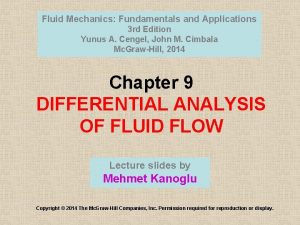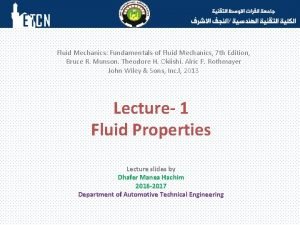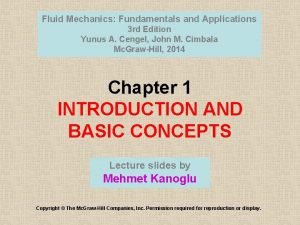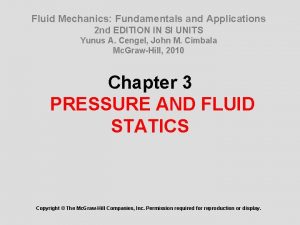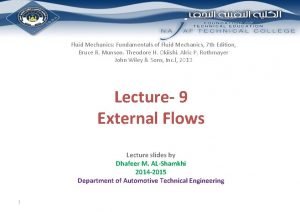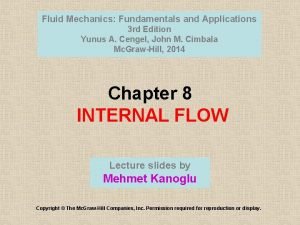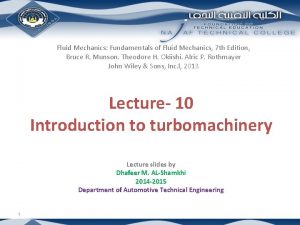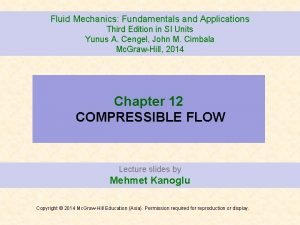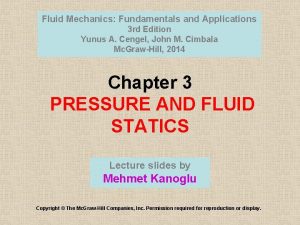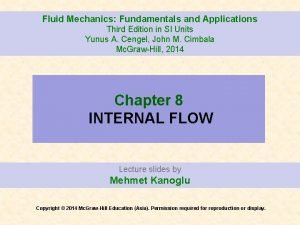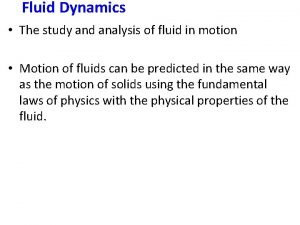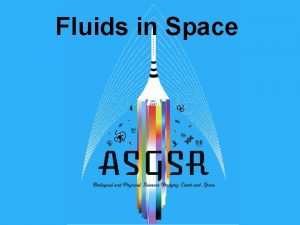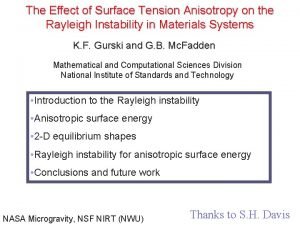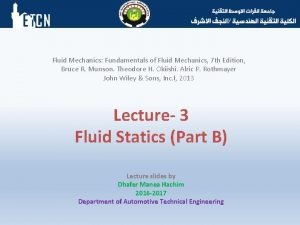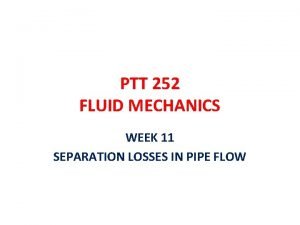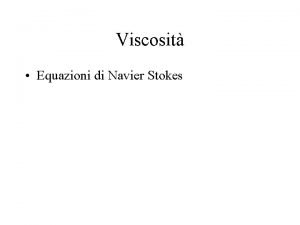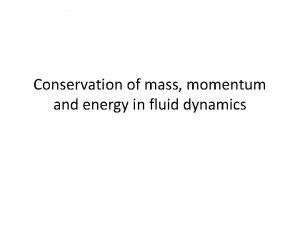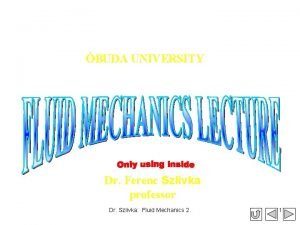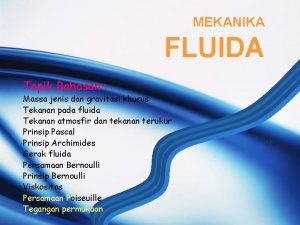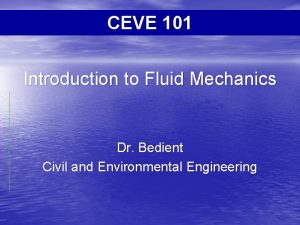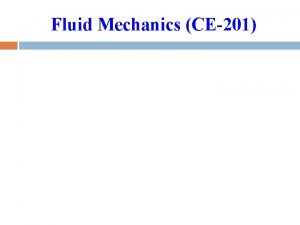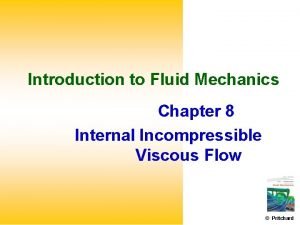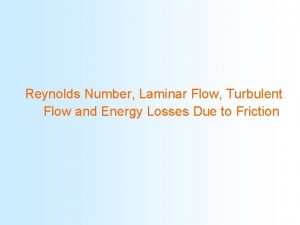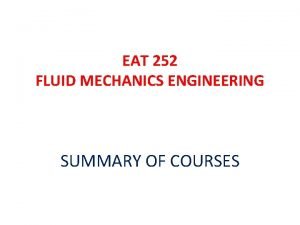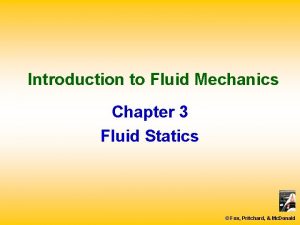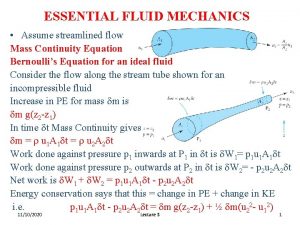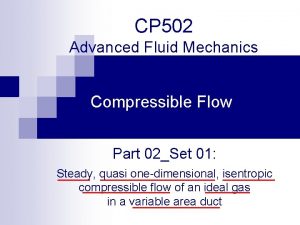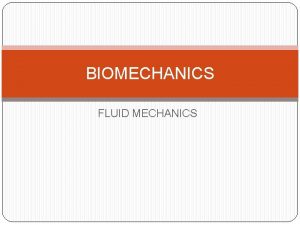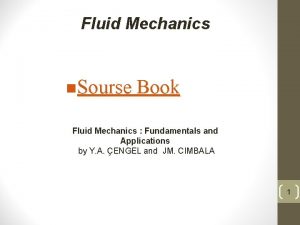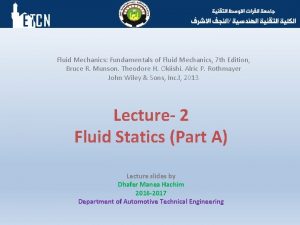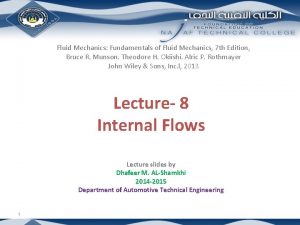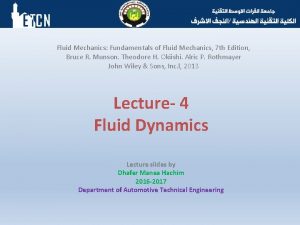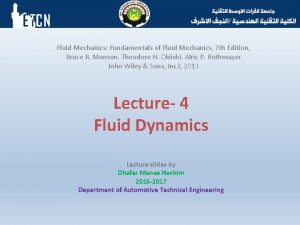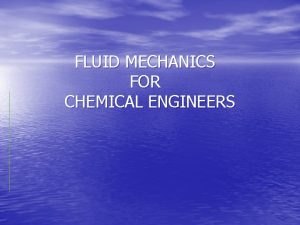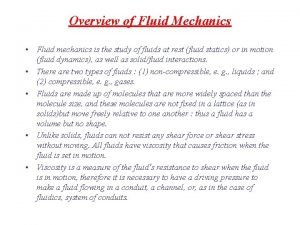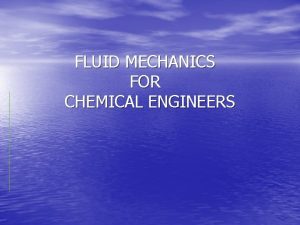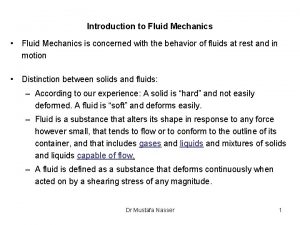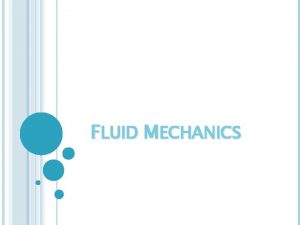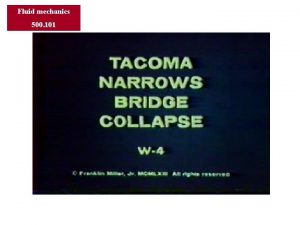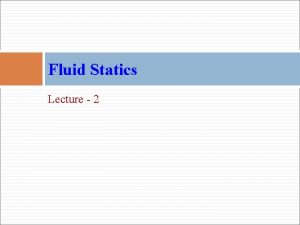Fluid Mechanics Fundamentals of Fluid Mechanics 7 th






































- Slides: 38

Fluid Mechanics: Fundamentals of Fluid Mechanics, 7 th Edition, Bruce R. Munson. Theodore H. Okiishi. Alric P. Rothmayer John Wiley & Sons, Inc. l, 2013 Lecture- 9 External Flows Lecture slides by Dhafeer M. AL-Shamkhi 2014 -2015 Department of Automotive Technical Engineering 1

Learning Objectives • After completing this Lecture, you should be able to: 1. identify and discuss the features of external flow. 2. explain the fundamental characteristics of a boundary layer, including laminar, transitional, and turbulent regimes. 3. calculate boundary layer parameters for flow past a flat plate. 4. provide a description of boundary layer separation. 5. calculate the lift and drag forces for various objects. 2

Outline • • • Review of Viscous Pipe Flow Laminar Pipe Flow Overview of External Flows Turbulent Pipe Flow Boundary Layer Characteristics • Pressure Gradients Effects • Lift and Drag 3

Viscous Pipe Flow: Review Pipe flow versus Open-channel flow: Pipe Flow: • Pipe is completely filled with fluid • Pressure gradients drive the flow • Gravity can also be important Open-Channel Flow: • Pipe is not full of fluids • Pressure gradient is constant • Gravity is the driving force i. e. , flow down a concrete spill way. 4

Viscous Pipe Flow: Flow Regime Osborne Reynolds Experiment to show the three regimes Laminar, Transitional, or Turbulent: Laminar “Experiment ”: Transitional Turbulent 5

Viscous Pipe Flow: Flow Regime If we measure the velocity at any given point with respect to time in the pipe: Re > 4000 Reynolds Number Dependency: 2100< Re < 4000 Re < 2100 1. Turbulence is characterized by random fluctuations. 2. Transitional flows are relatively steady accompanied by occasional burst. 3. Laminar flow is relatively steady. For laminar flow there is only flow direction: For turbulent flow, there is a predominate flow direction, but there are random components normal to the flow direction: 6

Viscous Pipe Flow: Entrance and Fully Developed The entrance region in a pipe flow is quite complex (1) to (2): The fluid enters the pipe with nearly uniform flow. The viscous effects create a boundary layer that merges. When they merge the flow is fully developed. There are estimates for determining the entrance length for pipe flows: and 7

External Flows: Overview If a body is immersed in a flow, we call it an external flow. External flows involving air are typically termed aerodynamics. Some important external flows include airplanes, motor vehicles, and flow around buildings. Typical quantities of interest are lift and drag acting on these objects. Often flow modeling is used to determine the flow fields in a wind tunnel or water tank. “Lift/Drag ”: 8

External Flows: Overview Types of External Flows: Two-Dimensional: infinitely long and of constant cross-sectional size and shape. Axisymmetric: formed by rotating their cross - sectional shape about the axis of symmetry. Three-Dimensional: may or may not possess a line of symmetry. The bodies can be classified as streamlined or blunt. The flow characteristics depend strongly on the amount of streamlining present. Streamlined object typically move more easily through a fluid. “Shapes” : 9

External Flows: Drag and Lift Pressure Distributions around an object (Bluff Body) lead to lift and drag. Shear Stresses on the surface also lead to lift and drag. Drag: Aligned with the Flow Pressure (Form) Drag + Skin Friction Drag projected area wetted area Lift: Normal to the Flow 9

External Flows: Friction and Pressure Coefficient τ w Friction Coefficient: C f = 1 ρU 2 Applying 2 p − p 0 Bernoulli Eq. Δp = Pressure Coefficient: C p = 1 ρU 2 2 Skin Friction Drag Coefficient: C D, f = Pressure Drag Coefficient: C D, p u 2 C p = 1− 2 U Df 1 ρU 2 × A wetted 2 Dp = 1 ρU 2 × Aprojected 2 Total Drag Coefficient: C D = C D, f + C D, p 11


External Flows: Boundary Layers Development of a Boundary Layer: Particles get distorted in the boundary layer. Viscous effects are important “Transition ”: Definitions: Boundary layer height: 13

External Flows: Boundary Layers Local Reynolds Number: Critical Reynolds Number: 14

External Flows: Boundary Layers Displacement Thickness: “Conservation of Mass” δ flow reduction = ∫(U − u) dy = U δ * 0 Momentum Thickness: “Momentum Flux” δ loss of momentum flux = ∫ ρ u (U − u) dy = ρ U 2 θ 0 15

External Flows: Boundary Layers Drag on a Flat Plate: Integral Relationships b is the width of the plate Note: 16

External Flows: Laminar Boundary Layers Flow over a Flat Plate can be Solved Exactly: Blasius Solution In 1908 H. Blasius (1883– 1970), one of Prandtl’s students Assumes Steady, 2 D Laminar, high Re Flow with negligible gravitational effects. From Boundary Layer Analysis: conservation of mass: momentum conservation: pressure is uniform across the boundary layer and is determined by the external flow. boundary conditions: at y=0: at y=δ: u=0, u=U, v=0, du/dy=constant, d 2 u/dy 2=0 du/dy=o 17

External Flows: Laminar Boundary Layers After solving, the governing equations with similarity variable: Boundary Layer Height: Displacement Thickness: Momentum Thickness: Wall Shear Stress: Coefficient of Friction: Coefficient of Drag: note: C D, f 1 L = ∫ 0 C f , x dx L 16

External Flows: Laminar Boundary Layers If we use various velocity profiles that match the boundary layer conditions of a velocity profile: 1 7

External Flows: Transitional and Turbulent Boundary Layers Turbulent Spots in Transitional Flow No real theories for transitional boundary layers. Turbulent boundary layers are very similar to those in pipe flow, and we can use some of those equations and theories. 18

Fully Developed Turbulent Flow: Overview Turbulent flow is the least understood of all flow phenomena, yet is more likely to occur than laminar flow, so we address ways of describing the flow. Transition from Laminar to Turbulent Flow in a Pipe: 19

Fully Developed Turbulent Flow: Overview One see fluctuation or randomness on the macroscopic scale. mean fluctuating One of the few ways we can describe turbulent flow is by describing it in terms of time-averaged means and fluctuating parts. 29

Fully Developed Turbulent Flow: Overview Now consider, the time average of the fluctuating parts: The fluctuations are equally distributed on either side of the average. Now, consider the average of the square of the fluctuations: Turbulence Intensity: Indication of the “gustiness” of the flow. in Atmosphere, In “good” wind tunnel 21

Fully Developed Turbulent Flow: Overview Now, shear stress: However, Laminar Flow: for turbulent flow. Turbulent Flow: “Experiment ”: Shear relates to random motion as particles glide smoothly past each other. Shear comes from eddy motion which have a more random motion and transfer momentum. For turbulent flow: Is the combination of laminar and turbulent shear. If there are no fluctuations, the result goes back to the laminar case. The turbulent shear stresses 22 (Reynolds Stresses) are positive, thus turbulent flows have more shear stress.

External Turbulent Flow: Velocity Profile The velocity profile for turbulent flow is been obtained through experimental analysis, dimensional analysis, and semiempirical theoretical efforts. 1/7 Power Law Boundary Layer Height: Displacement Thickness: Momentum Thickness: Wall Shear Stress: Coefficient of Friction: C f , x = 0. 0592 Re 1 x 5 Coefficient of Drag: 25

External Flows: Flow Past Objects Flat Plate Flow: Low Reynolds Number: Re = 0. 1 Large Boundary Layer Medium Reynolds Number: Re = 10 Large Reynolds Number: Re = 105 Thin Boundary Layer 26

External Flows: Flow Past Objects Symmetric Separation Wake 27

External Flows: Drag on Immersed Objects If there were not viscous effects acting on an object there would be no friction drag nor any pressure drag. Viscosity causes friction and separation which causes pressure drag. Friction Drag: the part of drag due directly to the shear stress Pressure Drag/Form Drag: the part of drag due directly to the pressure The Drag Coefficient is highly dependent on shape and the Reynolds Number: At the same Reynolds number, the above shapes have the same amount of drag. 28

External Flows: Separation In a situation where pressure increases down stream the fluid particles can move up against it by virtue of its kinetic energy. Inside the boundary layer the velocity in a layer could reduce so much that the kinetic energy of the fluid particles is no longer adequate to move the particles against the pressure gradient. This leads to flow reversal. Since the fluid layer higher up still have energy to mover forward a rolling of fluid streams occurs, which is called separation. “Separation ” 29

External Flows: Separation starts with zero velocity gradient at the wall Flow reversal takes place beyond separation point Adverse pressure gradient is necessary for separation (dp/dx >0) There is no pressure change after separation So, pressure in the separated region is constant. Fluid in turbulent boundary layer has appreciably more momentum than the flow of a laminar B. L. Thus a turbulent B. L can penetrate further into an adverse pressure gradient without 28 separation.

External Flows: Separation 29

External Flows: Separation Streamlining reduces adverse pressure gradient beyond the maximum thickness and delays separation Fluid particles lose kinetic energy near separation point. So these are either removed by suction or higher energy High energy fluid is blown near separation point Roughening surface to force early transition to turbulent boundary layer 39

External Flows: Drag on Immersed cylinder at very small velocities (Re<0. 5) the fluid sticks to the cylinder all the way round and never separate from cylinder. This produces a streamline pattern similar to that of an ideal fluid. as velocity increases the boundary layer breaks away and eddies are formed behind. Further increases in velocity cause the eddies to elongate. at Re number of around 90 the vortices break away alternatively form the top and bottom of the cylinder producing a vortex street in the wake region called Karman vortex street. Note: in the laminar flow as Re number increases, the separation point moves 31 to front.

External Flows: Drag on Immersed cylinder as flow within the boundary later becomes turbulent, the point of separation moves back producing a narrow wake since fluid particles have more kinetic energy (momentum) due to the nature of the turbulent flow (eddies existence). the friction drag is higher in the turbulent flow, but since pressure drag dominates, the net result is a significant reduction in the total drag. 32

External Flows: Drag on Immersed cylinder Roughness Effect: smooth ball rough ball (et. Golf ball) Wire Ring Effect: 35

External Flows: Drag on Immersed cylinder the front to rear pressure difference is greater for laminar flow, thus grater drag. 36

External Flows: Drag on Immersed Objects Drag on a Smooth Sphere and Cylinder: at Re<0. 5 the drag coefficient is at its highest and is mainly due to skin friction. as boundary layer becomes turbulent, a pronounced drop in the drag coefficient is produced. 35

External Flows: Lift on Immersed Objects Most all lift comes from pressure forces and not viscous forces. Most lift generating devices are not symmetrical. Lift can be generated by adjusting the angel of attack of the object. Lift and drag coefficients of wings are dependent on angle of attack. At large angles of attack, the boundary layer separates and the wing stalls. 36
 Fluid mechanics fundamentals and applications
Fluid mechanics fundamentals and applications Fluid mechanics fundamentals and applications
Fluid mechanics fundamentals and applications Fluid mechanics fundamentals and applications
Fluid mechanics fundamentals and applications Gage pressure
Gage pressure Momentum thickness turbulent boundary layer
Momentum thickness turbulent boundary layer Laminar flow
Laminar flow Energy equation with pump
Energy equation with pump Fanno flow
Fanno flow Fluid mechanics fundamentals and applications
Fluid mechanics fundamentals and applications Fluid mechanics fundamentals and applications 3rd edition
Fluid mechanics fundamentals and applications 3rd edition Hydraulic diameter
Hydraulic diameter Fluid kinematics
Fluid kinematics Synovial membrane
Synovial membrane Hypoosmotic
Hypoosmotic P1-p2
P1-p2 Extracellular fluid and interstitial fluid
Extracellular fluid and interstitial fluid Body fluid compartments
Body fluid compartments Fluid statics deals with
Fluid statics deals with Tense ascites meaning
Tense ascites meaning Interstitial fluid vs extracellular fluid
Interstitial fluid vs extracellular fluid What is discharge fluid mechanics
What is discharge fluid mechanics Fluidmechanics101
Fluidmechanics101 What is euler's equation
What is euler's equation Dimension of surface tension
Dimension of surface tension Dimensionless groups in fluid mechanics
Dimensionless groups in fluid mechanics Pressure prism fluid mechanics
Pressure prism fluid mechanics Head loss formula for sudden contraction
Head loss formula for sudden contraction Equazioni navier stokes
Equazioni navier stokes Ideal fluid
Ideal fluid Szlivka ferenc
Szlivka ferenc Gambar viskositas
Gambar viskositas Fluid mechanics 101
Fluid mechanics 101 Viscosity formula
Viscosity formula Fluid mechanics chapter 8 solutions
Fluid mechanics chapter 8 solutions Reynolds number
Reynolds number Fluid mechanics summary
Fluid mechanics summary Fluid mechanics chapter 3
Fluid mechanics chapter 3 Continuity equation
Continuity equation Compressible flow
Compressible flow
